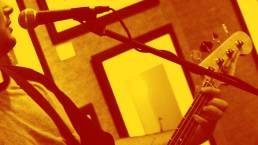
Designers, want to be better at what you do? Find your groove by sharpening these four essential bass-playing skills!
Back when I was younger, prettier, dumber, and even more pretentious than I am now, I played bass guitar and wrote song lyrics in three bands. If you know me, that’s not news — I bring it up…well, often — but I’m hauling it out this time because now it’s actually useful. Yeah man, now it’s wisdom. See, I’ve survived fifteen years as a professional designer with only a few stupid mistakes to my name, and I credit that lucky streak to my prior ten years as an amateur bassist.
You read that right: everything I ever needed to know about professional creativity I learned in anonymous rock bands.
It was the perfect setting to make mistakes. I got to outgrow poor management habits, raging self-absorption, stunted communication skills, and umpteen other hangups that would have sunk me if I’d entered the design biz any earlier than the ripe old rockstar-killing age of 27. From backyard keggers to dive bars to truly inspiring studio spaces, the lessons were pretty much the same: show up on time, know the songs, back up your friends, and keep the crowd movin’.
I never went to design school (I was an English major), so the aspects of design that I got most comfortable with weren’t that different from what I learned being a bassist. It’s an odd position in a band, and routinely mocked. The bassist is either a faceless nobody hidden near the drums, plunking out the same three notes per song, or an egomaniacal bastard who’s ditched their proper place to seize the spotlight. Designers can suffer from those caricatures too, but in my experience a good designer shows all the qualities of a good bassist: be reliable, be efficient, be collaborative, and be strategic. None of that sounds very rock and roll, but I promise you it works. Here’s how:
Be Reliable
Start stable and stay steady.
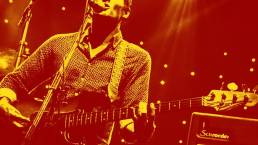
Ninety percent of success really is just showing up and doing your job. Steadiness and stability can seem boring and repetitive in our ruthlessly callous, carpe-diem society, but in the creative industries, people who embody reliability are light-years ahead of their flakier, less-motivated peers. They’re also ahead of their willing and eager but less-disciplined peers. Depending on a spastic, feast-or-famine inspiration cycle is no way to be creative. Professional creativity costs time and money, so it’s gotta have process and structure to balance out the kind of unconventional thinking that solves problems.
In a band, the rhythm section dishes out consistency like a groovy assembly line. It starts with the drummer, of course ( a whole other essay in itself) but the bassist is critical too, because the bass is a percussion instrument with strings, not just an excuse to put your best friend on stage. It’s the musical bridge between the drums and the other instruments, and the best bassists know this. They stay well-rehearsed, learning their parts before practicing with the full band. They’re also punctual, because setting up gear and tuning your instrument takes time. They care about their gear, keeping guitars, cables, amplifiers and other equipment in fighting shape for every rehearsal, gig, and tour. For the band to fire on all cylinders, everyone’s gotta bring their propane, so unreliable bass players won’t last long.
How does that translate to design, you ask? Almost seamlessly.
Designers foster and refine connections between a brand and its audience, with people counting on them at every project stage, so all the same skills apply:
- Showing up on time? Check. Even if you’re a freelancer or working from home. Do and be what you’ve promised to do and be.
- Staying well-prepared? Check. Pay attention to design industry trends to know when (or when not) to tailor your work to look current.
- Keep your skills sharp. If you know your typography, color theory, layout, or how to work with hierarchies, you’ll always be better than a teenager with Photoshop.
- That said, know your tools, both slick software and traditional hardware, so you can credibly work with printers, photographers, and all your other creative colleagues.
But wait — doesn’t all that structure stunt designerly creative thinking? Not at all! Do it to it, just have standards and stick to them. Don’t let anyone tell you reliability can’t rock.

Be Efficient
Focus on essentials, not expression.
My working philosophy for both bass and design is “play only the notes you need to play.” That usually means I’m spending more time editing than creating, because why play ten notes when five — or even three — can do the job? Working within boundaries can often spawn better creativity than running wild with no limits. Creating with constraints shows patience in your craft and confidence in your expertise, because you don’t have to be a virtuoso to do a good job. Oh sure, there’s a time and place for virtuosity, but constant, literal awesomeness is exhausting, so I try to avoid being gratuitously flashy and instead focus on essentials instead of expression.

Playing bass isn’t about improvisation anyway. I mean, unless you’re this guy, you’re only working with four strings (don’t @ me about those five- or six-string abominations) and they’re thick as hell. Do you really wanna stretch for that low F every eight bars? No. All you need to do is help the drummer make a solid musical foundation for the lead instruments like guitar, keyboards, or vocals to do their thing. Playing “in the pocket,” or in perfect sync with the drummer, is every great bassist’s first goal. Bass notes played over the kick drum get an extra punch, and the notes in between the beats build a bridge for the song to move along. Playing efficiently means playing organized, methodical, and systematic, with no room for showboating.
In design, efficiency is all about mastering time management.
The only thing designers can charge for is time. Experience helps here — like say an internship at an agency, where you can see the whole project happen — because good time management means never starting from a blank canvas with no information. You have to:
- Know the production time a given project might take, so you can estimate accurate costs and timelines.
- Know your abilities with each tool and use pre-built templates and well-outlined processes for setting project milestones.
- Know what assets you’ll need. Get all the photos, graphics, fonts, copy, and anything else before you fire up that Adobe suite.
- Know your contacts. Figure out when to work with a single client contact and when to include every decision-making stakeholder for smooth project reviews.
- Know how to communicate clearly when writing or speaking to justify your decisions and avoid confusion.
Efficient designers create accessible designs: systems that are easy to understand, products that are easy to use, text that’s easy to read, and imagery that’s easy to comprehend.
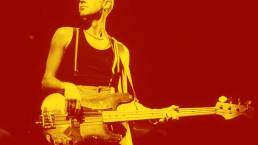
Be Collaborative
Cooperation beats celebrity, every time.
Quick, how many solo bassists can you name? Not songwriters with backing bands — solo bass players whose gig is just them and their instrument. Very few, right? There’s a reason for that, and it’s not just because the only people who dig solo bass albums are bassists. It’s because, again, the bass is not a lead instrument. It sounds best in context, playing its role in the song, because bass players fit best in a group. The same is true for freelance designers versus agency or in-house designers, because a freelancer isn’t just a designer — they’re a business owner, marketing officer, HR department, the works. It’s a huge difference. Trust me on that one.
Playing in a band — even as a duo — is more fun, rich and collaborative than flying solo. The independence is great, but the workload will punish you without help. Even in a band, though, you gotta work up the empathy to trust the other talented jokers enough for everyone to create the proverbial beautiful music together. That only happens when each band member understands their role on the team. I’m not saying restrict each person to a straitjacketed set of tasks. I mean trust your team to know what they’re doing, and if they’re worth working with, they’ll reciprocate that trust. Not many bassists make it as frontmen or even bandleaders, and I say this from painful, embarrassing experience, because that’s not the bassist’s best role. It’s less Sting or Geddy and more James Jamerson.
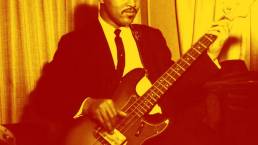
As a designer, you also have to understand and accept your role, even and especially if it’s different for each client or even each project.
- You’re not the lead, even if you’re the “design lead.” Your client is the lead. You create the thing or space or idea for them to expand on.
- I’m gonna repeat that, because it’s important: you’re not the star. Rock star designers are anything but; indeed they’re toxic to good design because they make it about them instead of the work.
- Speaking of the work, never get too precious about what you make. Let it go and accept criticism — or rather know the difference between constructive feedback, envious flattery, and useless crap.
- First drafts are just that, and everything you create will be mangled and misinterpreted as soon as it leaves your head. You’re not making the work for you, you’re making it for your client, or more accurately, your client’s customers!
Get as comfortable with your role on a team as you can, so if you get a chance to step out of your role — to get promoted, to try a new technique, whatever — that step will feel like a leap: refreshing, surprising, and all-around delightful.
Be Strategic
Empathy fosters engagement.
At this point, I should probably admit that I’ve never been a people person. I mean, I can fake it really well by now, but my favorite state of being is to get head-down-locked-in the zone, man — to sit in the corner and do what I love and not be pestered by anyone. Snap on my noise-canceling headphones and just flat-out produce for hours at a time. When I’m on, I’m on — and it’s glorious and fun and addicting — but y’all, I’m telling you it’s a dangerous game when unchecked. As a bassist and a designer, permanent self-indulgence when creating is absolutely detrimental. Don’t lose touch with what really matters: your people!
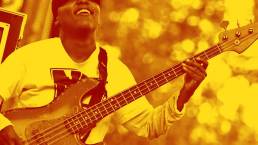
Lesson one for bassists is “stay on the beat,” and…sure, if you do that, then technically you’re playing bass. Why are you playing, though? For fun? For money? Because you’re good at it? “Yes” to all of those, right? If you only care about the “what” and not the “why,” you’re missing the point. The best bassists don’t just play for themselves. They don’t even play for their band. They play for the audience! They want everyone to move it, to shake it, to be engaged in a communal celebration of sound. And yeah, that’s what the record-company suits call “forward-thinking,” “big-picture,” or “goal-oriented,” but that doesn’t mean it’s wrong! If you can make the crowd move, then you’re winning. The bean-counters may call it “outcome-oriented,” but it’s really empathy. Empathy is paramount. An empathetic bassist is doing it how it oughtta be done.
Designers with empathy can think strategically.
Yes, it’s a buzzword, but it’s buzzing for a reason. A designer with empathy for how other people might use, interpret, or even break their design is better than any other designer lacking foresight, perspective, or vision. So yes, design has to be “outcome-oriented” and user-friendly. That’s why design ain’t art; artists can ask questions, but designers must answer them. Art can be gloriously, transgressively expressive, but design has to be intuitive and approachable or else it’s not doing its job: considering the user first. Even some “bad” design is done that way for a reason; lurid colors and odd shapes grabbing your eyeballs, or obnoxious wayfinding getting you from A to B is engaging you. Considering how someone will engage with your work — and translating that to what you’re making — means you’re an empathetic designer. Don’t just trust your gut; do your homework, compile your research, listen to your users, and then do the work.
Ready to Rumble?
Mash up passion and profession!

In any creative arrangement, somebody’s gotta be the glue. Someone has to be the anchor keeping everyone else focused on what matters: helping the lead instruments back to the beat, or tethering a design to the creative brief or client goals. For me, linking up bass guitar and graphic design was the perfect connection to get better at both. I learned to be that connective tissue. I learned how to get sound and rhythm to move crowds of people. I learned how to be part of a team and unify wildly disparate musical influences into a new, unique sound. I learned how to use creative thinking to set smart goals, apply systems, and solve problems.
I wouldn’t have learned any of this without help from brilliant and talented friends, musicians, collaborators, colleagues, and yes, even clients. They taught me to not rely on tools alone. They taught me that rehearsal beats improv. They taught me that process matters, but that the final version isn’t always the final outcome. They taught me that reliability, efficiency, collaboration, and strategy are the best skills to create a thing or space or idea for others to build on or take and run with. They taught me that it’s fine — desirable, even — to let your work be tested and twisted and maybe even destroyed by the outside world. I got real lucky, folks. I got to find my groove, and then find it again. How often does that happen?